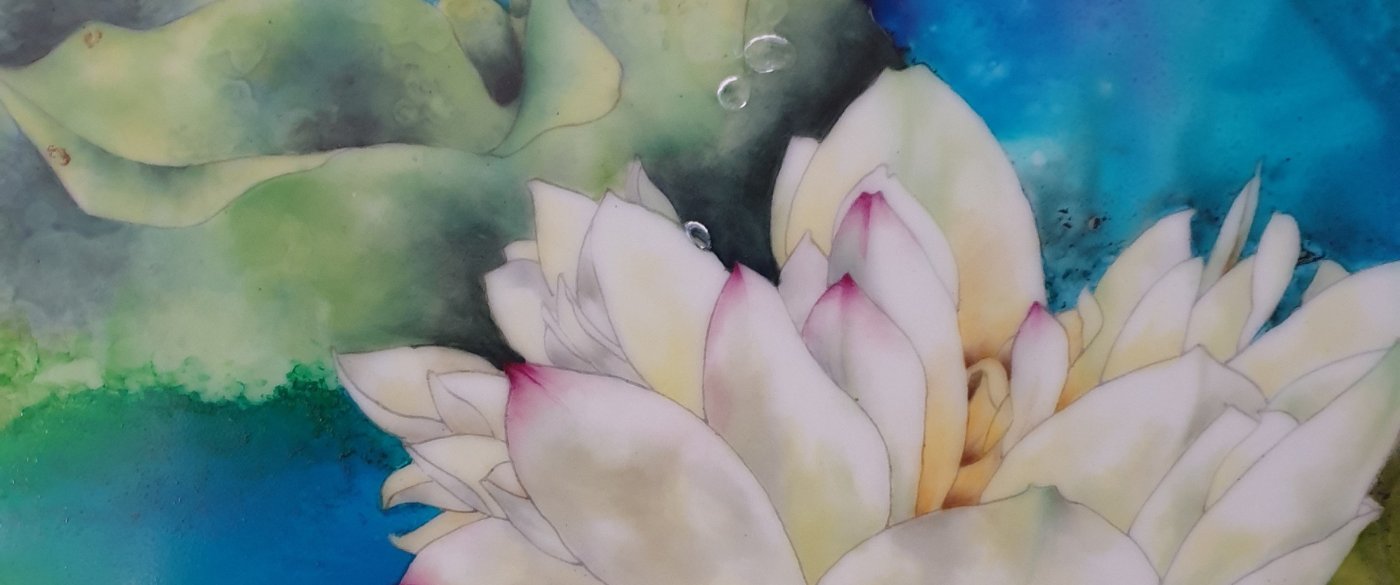By Di Curtin – 2023
REQUIREMENTS:
- Pinata Inks – including Opaque White
- Methylated spirits
- Extender for inks
- Isopropyl rubbing alcohol
- Windsor and Newton masking fluid
- Lots of throw away containers and old brushes
- Patience
These inks are very vibrant in colour and you will need to take that into
account when designing and planning your artwork. The inks must enhance
not take over from your subject matter – so choose carefully what you will
combine them with.
I have found that lotus flowers are a great complimentary flower for this method of painting. You can also combine with porcelain painting and achieve great effects, especially with our outback colours and animals.

Mask out the subject matter with the masking fluid, give it two or three heavy coats. Trust me you don’t want a thin coat, it will string off in bits and drive you crazy trying to clean it all off. (been there done that)
Once that is done rub the area intended for floated inks with isopropyl alcohol, make it nice and wet. This will act as a bath for the colours to be dropped into.
Proceed dropping your colours in (not too many colours at once – don’t want it
looking like a dogs dinner!) – be aware of what happens with colours when
they mix. Once all the colour is on the background tilt the tile to flow the inks
together. Work quickly as they will dry fairly rapidly. The isopropyl will slow
that down a little for you. You can also have a go using the extender product in
the same manner. See what you think is best for you.
If you start getting hard lines, then its beginning to dry. You can spray that
area with isopropyl and it will soften the line for you and sometimes leave a
soft pattern of colour. When you are happy with the colours, lay the tile flat so
everything can stop flowing and settle. Let dry and begin taking off the
masking carefully.
Clean up any edges with a pen nib, by scratching away unwanted colour. Be
careful here as it can chip in small bits if the colour is dense. I have found that the darker colours have a lot of pigment floating in them – so I use that as texture. Dust will stick to the inks also. You will notice on my work lots of dots – this is done with a Posca Pen to disguise the dust spots. (Peter Faust style)
Adding methylated spirits to the floated inks will repel the ink and leave a hard edge – great if that’s the effect you want. Isopropyl is a softer alternative.

Extender mixed with colour is also a soft way of adding in bits of colour.
Opaque white is a heavy ink that is interesting. It creates unusual edges, but
will mostly stay in the shape of a drop as it is so heavy. Make sure you tilt,
push or move it with products so its not just in one blob.
With some of my works, I have been unhappy with the colour – mostly being
too intense for the subject. I then used a pipette with methylated spirits in it –
tilted the tile and then squirted the meths from the side to move the colour
and also to dilute the intensity. By doing this you will thin out the inks and
they will be quite matt. But it does achieve some lovely effects.
Work into the ink with fine brushes to created leaves and branches.
The Pigmy Possum – the colour was floated. It wasn’t what I had intended, so
took cotton buds dipped in meths and proceeded to cut back a background to
reveal shapes of trees and branches. Use the colours already there to give you
some ideas on where to place things. The bottle brush was painted over the
top and near the branches with a fine brush. Finished off with the Posca Pen.
I choose not to seal the inks, I have tried and found it not successful as it tends
to pool in small dimples. And then it has to all come off. So the alternative is
to frame it under glass in a box frame. And make note to the buyer if any, that
it will come off if wiped if it is ever reframed etc.

